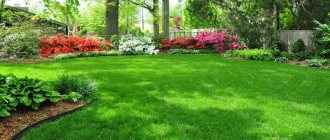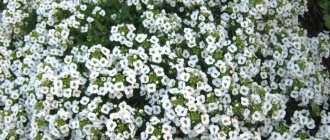In an effort to create a landscape design at their dacha with their own hands, many gardeners make the grave mistake of planting only shrubs, trees and flower beds, while completely forgetting about the “flooring” of the garden - the lawn.
But what if, after hearing a lot about the difficulties of growing lawn grass, you are worried that you simply do not have enough energy to prepare the site, fight difficult-to-eradicate weeds, painstakingly grow seeds, fertilize, regularly water and mow? There is a way out - sow the area not with grass, but with a flowering lawn mixture and create a colorful, easy-to-maintain Moorish lawn at your dacha.
Such a decorative variegated or single-colored lawn is formed by including thirty or even forty meadow flowers and grasses in the traditional mixture for lawn grass.
DIY Moorish lawn
What is Moorish lawn
The village lawn owes its appearance to the Moors (hence the name), who once, many centuries ago, owned part of Spain. Travelers who first set foot in the city of Cordoba, the center of Moorish art, culture and science, were amazed by the richness of the ennobled oasis. Everything in this cozy city was incredibly beautiful. But the garden laid out around the palace was especially beautiful. Well-groomed and large, with fountains and ponds, it was all planted with wildflowers, emerald lawn grass and ornamental grasses.
The new solution to the usual lawn was to the liking of European nomads. They adopted the custom of planting wild flowering grasses and grains in desert areas, partially replacing their neatly trimmed lawns with naturally beautiful, low-maintenance flowering meadows - Moorish-style lawns.
The advantage of lawns of this type lies mainly in the fact that they can be located even in those areas of the garden where the soil is depleted and dried out (or waterlogged). You don’t have to spend a lot of money on them, and it’s very easy to select seeds for a perennial flowering lawn. In order for an ornamental meadow to be covered in flowering throughout the entire season, it is enough to know the flowering time of each plant in the composition.
Tulips
A famous spring flower that blooms in early summer. There is only one elastic bud on the thick green stem, which opens during the day and closes at night.
There are more than 114 varieties of tulips. They are distinguished by the shape, size and type of petals, as well as color. In addition to the usual red and yellow tulips, there are pink, burgundy and even blue tulips. The tulip is quite resistant to temperatures, but loves warmth. Flowers planted with bulbs can grow in one place for up to 6 years.
Cereals, flowers and herbs for the Moorish lawn
So, you have made the final decision to lay out a Moorish lawn at your dacha. Plant seeds for a multi-colored meadow should be chosen that are unpretentious and easy to care for. The area is sown with special mixtures of perennial cereal grasses with the inclusion of perennial and decorative flowering flowers. (The higher the sowing rate, the closer together the flowers will grow).
Important! All flowers should bloom for a long time. And then, after flowering, drop the seeds so that they can germinate again next year.
The best plants for a Moorish lawn
Ornamental perennial grasses
- The bentgrass is thin;
- Timothy grass;
- Fragrant bison;
- Red fescue;
- Meadow bluegrass;
- Zhitnyak;
- Lagurus;
- Perennial ryegrass.
Early flowering bulbous
- Scilla;
- Snowmen;
- Tulips;
- Bow-anzur;
- Grouse;
- Daffodils;
- Crocuses;
- Cyclamens.
Meadow (wild) perennial flowers
- Californian and oriental poppy;
- Nemesia;
- Meadow chamomile;
- Echinacea;
- Quaking grass;
- Arnica;
- Gaillardia spinosa;
- Gentian;
- Loosestrife;
- Tansy.
Annual plants
- Forget-me-nots;
- Nemesia;
- Mattiola bicornuum;
- Delphinium;
- Chernushka;
- Cornflowers;
- Dimorphotheca emarginata;
- catchment;
- Marigold;
- Bells;
- Gypsophila;
- Phlox drummond;
- Linen;
- Lobularia marine;
- Daisies;
- Clover;
- Phacelia bell-shaped;
- Primrose;
- Carnations;
- Nasturtiums;
- Goldenrod;
- Agrostemma sativa;
- Snapdragon;
- Lenyanka and others.
When decorating a low Moorish lawn, anise, thyme, mint and lemon balm are often used. High - fragrant herbs and flowers that release a lot of pollen and thereby attract colorful butterflies and honey bees to the garden.
The bulbous plants in the Moorish lawn will be the first to color the garden in the spring, while other meadow plants barely emerge from the soil. In the summer, when the primroses turn yellow, their fading leaves will be hidden by the lush colors of grass and meadow flowers.
Advice. If you are a beginner, then it is better to start sowing a Moorish lawn with a one-component mixture - without proper, although not difficult, care, a multi-component lawn of several plants will after a while resemble not a charming lawn, but a front garden with weeds. (A lawn made from low-grade carnations and thyme turns out to be incredibly fabulous – it’s a pleasure to grow it yourself).
In the photo below, the following flowers are sown for the Moorish lawn: blue cornflower, chrysanthemum sativa, poppy, common agrostemma and field navel.
Moorish lawn - composition
Material prepared for the website www.moydomik.net
Such a wonderful variegated lawn was made from only 5 species of field plants (on average, a Moorish meadow can include 20-40 unpretentious cereals and flowers). It all depends on the landscape design of your garden.
Calendula
An unpretentious, annual plant, well known for its medicinal properties. Tinctures, decoctions and ointments used in medicine and cosmetology are made from the inflorescences.
In landscape design, as a rule, medicinal and field calendula are used. Medicinal calendula is small, approximately 10-30 cm, blooms from May to June. It gave rise to many varieties that differ in flowering periods and color from bright orange, golden, to peach-yellow.
Moorish lawn - buy or sow it yourself?
It is easy to buy a mixture for a Moorish lawn for little money in a store for gardeners and summer residents (it is recommended to give preference to domestic seeds) or make the mixture yourself. If we talk about the approximate ratio of plants, it should be as follows: 80% cereal herbs and 20% flowers. Sow the mixture at the rate of 10 g per 1 square meter. m.
If you really want a strongly flowering lawn, then do exactly the opposite of what you would do with store-bought mixtures. Make up your lawn with 70% annuals and 20% short grass. It will turn out very beautiful.
Sowing of the Moorish lawn is carried out in the same way as decorative lawn grass - in early spring. In order for the plants to fully develop and bloom, it is recommended to plant them in unshaded places. If you are planning to organize a meadow among trees, then give preference to plants such as ifheion, kandyk, lily, white flower, arizema, anemone, arum, trillium, snowdrop, etc.
When creating a magnificent living carpet, do not allocate too large, well-lit area for it.
Daisies
The first daisies bloom already in April, and flowering continues until autumn. The variety of varieties allows you to choose the flowers most suitable for your garden.
The height of daisies can be from 10 to 30 cm, and the flowers can be both small (1 cm) and large (8 cm). The flower is double, white with a yellow core, red, bicolor.
Although daisies are perennials, gardeners specifically limit their lifespan to 2-3 years to prevent degeneration. The plant needs constant watering, it will take fertilizer well, but can do without additional feeding.
Planting a Moorish lawn - step-by-step instructions
- Step 1
We free the soil from weeds (we treat heavily infected areas with glyphosate several times) and, after about a month, remove the top layer of soil to a depth of 8-10 cm.
- Step 2
We carefully dig the soil with a shovel to a depth of 25 cm and add low-fat organic fertilizers, sand and peat. This should be done 8-10 days before sowing.
- Step 3
We provide a slope of 3 degrees to drain rainwater from the lawn. (By installing high-quality drainage, you will prevent your flowering lawn from turning into a swamp due to prolonged summer downpours).
- Step 4
Immediately before planting, we level and compact the soil with a bayonet shovel and rake, and then with a garden roller. It is recommended to do this in dry weather.
- Step 5
After leveling, we once again go over the surface of the area with a special lawn rake. This is necessary in order to remove the newly formed bumps after compaction.
- Step 6
On a flat, soft and moderately moist surface, manually sow a mixture for a Moorish lawn mixed with sand in a ratio of 1:3 (approximately 0.0001 g of seeds per 100 g of dry sand). You can sow the area evenly or make islands of flowers by first sowing cereal grasses, and meadow flowers between them.
- Step 7
We immerse the seeds with a rake to a depth of 5 mm, roll them up and carry out drip irrigation (strong water pressure can wash out the crops).
- Step 8
We cover the area with non-woven material - in this case the shoots will be uniform and friendly. But even if the seedlings seem too rare to you, under no circumstances rush to finish sowing - forbs sprout at different times, sometimes the interval can reach 4 weeks.
Flax grandiflora
An interesting fast-growing annual, up to 60 cm in height. One 3-5 centimeter flower blooms for only a day, and the next day another one opens from the inflorescence.
Depending on the variety, the shape and color of the flowers change. They can be white star-shaped, white with a cherry center, blue with a yellow center, deep red and pink, salmon and apricot.
Flax reproduces by self-sowing, but you can collect some seeds for next year. It blooms from July until frost, but is very dependent on the number of sunny days.
Moorish lawn care
Lawn mowing
Unlike a parterre or ordinary lawn, the Moorish lawn is cut for the first time at the end of June (when spring flowers are seeded) and the second time in October. But, of course, this is an approximate diagram. A fast-growing lawn may also need mowing in August.
Mowing is another matter. In the first year, it is done in order to prevent fast-growing cereal grasses from drowning out annual wildflowers and to prevent perennials from gaining full strength.
Advice. The first mowing is done in the spring, when the flowers have not yet appeared and the grass has already sprouted.
When there are a lot of early-flowering bulbs in the mixture, mowing the turf is done with a scythe or trimming scissors with extreme caution. The mown grass is carefully raked and removed from the area.
Mowing the Moorish lawn
Removing weeds from the lawn
Weeds will have to be destroyed manually. It will be much more convenient to do this if you plant your lawn with meadow flowers in a narrow strip on the border of the garden or near the fence.
Regular watering of the lawn
High-quality watering is very important in the first two weeks after sowing the lawn. In order not to ruin the newly hatched seedlings, watering should be done by shallow sprinkling, carefully, in several passes. After all the seeds have sprouted, you need to monitor the soil moisture. If necessary, artificial irrigation is carried out.
Lawn Fertilizer
We have already said that the Moorish lawn is the most unpretentious of all. But if you see that the plants in your meadow are growing poorly and turning yellow, this is a reason to carry out unscheduled (minimal!) fertilizing. The most convenient way to feed is complex fertilizers for a flowering lawn, which contain several easily digestible micronutrients. But in no case should you feed your lawn during the first year of life after sowing - complex fertilizers can ruin it. This can only be done next year.
Loosening and aeration of a flowering lawn
An important stage in caring for a Moorish lawn is aeration (ventilation). It is carried out to organize gas exchange between external (atmospheric) air and subsoil air. The essence of the aeration process is to shallowly pierce the soil with a pitchfork or fan rake. Aeration will eliminate “bald” spots and prevent the death of plants that, for example, wither due to rotten roots.
Loosening and aeration of the Moorish lawn
There is one important note: do you want your lawn to be neat and beautifully blooming next year? In late autumn, pull out all the flowers and replant the Moorish lawn next year!
Meadow chamomile
Or common popovnik, which should not be confused with chamomile. A multicolored herbaceous plant with a height of 60 to 90 cm. The flower is recognizable: a massive yellow basket framed by white elongated petals.
It begins to bloom in March and ends in late autumn. Loves the sun. For its full growth, you should choose neutral or slightly acidic soils, and also avoid stagnant water.
Moorish lawn – photo
Moorish lawn at a summer cottage
Blooming Moorish lawn on the site
Bright Moorish lawn
Country Moorish lawn
Moorish lawn in the garden
Forget-me-nots
A perennial with a branched stem, small blue, pink or white flowers are collected in inflorescences. Flowering lasts all summer and extends into September.
There are more than 45 species of forget-me-nots. Of these, the most popular are swamp, forest and alpine garden. On a personal plot you can most often find a garden plant. Flower growers fell in love with it for its endurance and the minimal care that the plant requires.
It is not recommended to grow forget-me-not for more than 2 years, as over time it grows, the flower becomes smaller and loses its appearance.
Story
In the 7-8 centuries AD, when the Arabs and Moors founded their states in North Africa (see Maghreb) and Spain, their rulers - caliphs and emirs (governors of various taifa principalities) began to build grandiose palaces. Hundreds of gardeners, brought from different parts of the world, worked to create wonderful gardens and parks in which European, Mediterranean and Oriental elements intertwined. During the times of developed feudalism, a significant part of certain layers of the population of nominally Islamic principalities were Orientalized Sakaliba Slavs, who, as a rule, came to Spain from Crimea through Constantinople in various ways as mercenaries and slaves. In the 12th-13th centuries they were already quite widely represented in the military class, as well as among the workforce and servants. It is thanks to the influence [ source not specified 1900 days
] to their taste, the Moorish lawn began to more and more resemble a brightly blooming field meadow of Russian forest-steppes.
As a result, in the palace parks of the Sultans of Spain, between the neat trees, instead of the characteristic [ source not specified 1900 days
] green grass for Northern Europe, the earth was full of colors of modest, but extremely attractive wildflowers. Most of the plants that make up the Moorish lawn are excellent honey plants and attract a significant number of bees, bumblebees, and butterflies. This makes the lawn even more beautiful and gives it a special charm.
PREPARATION
The soil must be prepared in the same way as for a regular lawn: it must be cleared of weeds, very carefully dug up and fed (preferably with complex fertilizers if this happens in the spring).
An important condition: the dug area should be rolled and the soil leveled so that there is no stagnation of water in uneven areas and the seeds fall evenly on the ground. Sowing should begin in the first half of May, the weather should be calm, it is necessary to sow in moist soil, since many flowers have very small seeds that can fly outside the cultivated area
Next, carefully embed the scattered seeds into the soil using a fan rake. It’s great if you have a lawn roller: you can use it; if not, you can simply water the lawn thoroughly with a light sprinkler.
Link on topic: Do-it-yourself lawn at the dacha: care, sowing, etc.
Peculiarities
This lawn option is optimal for those homeowners who do not have much desire or time to regularly use a lawn mower on their property. Creating a Moorish canvas allows you to get a small lawn that will delight you with its bright blooms throughout the warm season.
To create a lawn, special grain mixtures are used. Most of them are cereals - they are responsible for the formation of a dense base. The share of flowering crops accounts for about a third of the total volume of seed material.
Any flower shop sells ready-made mixtures for flowering herbs; they can be sold under the names “blooming” or “alpine” lawn. If desired, anyone can create a grass mixture for such an unusual lawn with their own hands.
Ideas from the designer
There are several more ways to create decorative lawns, which are recommended by I.K. Barysheva. They are somewhat more difficult to perform, but the result is worth the effort.
Either a meadow or a corner of a garden.
Meadow lawn, or cultivated meadow
Compound:
- ready-made mixture “Ordinary lawn”;
- red and white clover;
- alfalfa;
- sainfoin;
- You can add small bulbous flowers and small annuals.
Flaws:
- does not tolerate prolonged trampling;
- it cannot be arranged everywhere, only along the periphery of the site;
- due to the large number of weeds it looks untidy;
- more difficult to create than a regular lawn.
Pros:
- can be cut once a month;
- The decorative effect is increased due to the fact that such a lawn is cut higher than a regular one, and this cutting allows you to create good decorative lines in the landscape.
Clover is included in many flower lawn mixtures











